
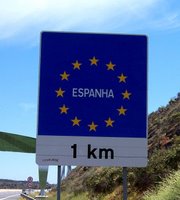
TO ALL,
This could be a rather long travelogue so feel free to save, delete, or unsubscribe as suits your fancy. We have just returned from a fabulous, sunny 9 day trip to Spain and parts beyond. It was Deanna’s spring break and we covered a lot of ground and had a lot of fun. We spent a day in Gibraltar, a day in Tangiers, Morocco, 2 days exploring the “White Hill Towns” of Andalucia, Spain, 3 days in Portugal and an afternoon in Sevilla, Spain. It was all wonderful.
We flew (Ryanair again) to Jerez, Spain and made the Naval Station at Rota our home base (camping one night in Andalucia and 2 nights in Portugal but always returning to Rota). We were told by the gate guard at Rota that we could NOT use the commissary and NEX at Rota since we weren’t assigned there, but somehow we did it anyway. It was sunny most or all of every day we were there - some days a little too windy, but other days absolutely perfect.
Spain is definitely NOT a third world country. In the US, I think most people tend to assume that Spain is like Mexico, pretty in it’s own way, but also dirty and crowded and poor. We found that Spain and Mexico have very little in common other than the language and the bullfighting (more about that later.) Even the food is not at all the same. Deanna and Amy have both announced that they like Spain better than Germany. Maybe because they both know a lot more Spanish than German??? Also because they’ve spent most of their lives in the western part of the US and are used to wide open spaces. In Germany you are very rarely out of sight of some little town or another.
Amy has not been able to drive in Germany because she hasn’t gotten around to taking the written test that is required to legally drive a car licensed by USAREUR (United States Army Europe). She can, however, drive a rent car, so she did lots of driving on this trip. Our rent car was a standard transmission. She just barely knew how to drive a standard when we got to Jerez - now she is pretty good at it. In between . . . . well . . . . . the first time we drove through the gate at Rota Naval Station, Amy was driving and she had a terrible time getting moving again from a dead stop. After she had started and killed the car a couple of times, the gate guard (Spanish Military) stopped the incoming traffic and came over to her window to give her a little lecture on how to drive a standard (in Spanish of course!) The key word in his little lecture was “suave” - the Spanish word for “smoothly.” At some point Amy said (in Spanish) “I understand but it’s hard.” He said, “No it’s not. It’s easy!” In the “White Hill Towns” there are a lot of very narrow streets that go straight up -- really, really steep. A couple of times Amy had to ask Mike to take over and they did a Chinese fire drill in the middle of the street, but for the most part Amy did really well, with a minimal amount of cussing. Who but Amy would attempt t o learn to drive a stick shift in a foreign country? She must have an especially large dose of “Risch determination.” Look out world!
o learn to drive a stick shift in a foreign country? She must have an especially large dose of “Risch determination.” Look out world!
Our first full day out we went to Gibraltar. Gibraltar is a giant rock monolith connected to the mainland of Spain by a narrow sandy isthmus. It was seized by Great Britain in the War of Spanish Succession (1713) and never returned to Spain. The Spaniards are still ticked about that and they retaliate by making things like border crossings and telephone connections difficult. There is an airstrip on the sandy isthmus, largely on reclaimed land, that has been a lifeline in times past when Spain has closed the border. We parked on the Spanish side  of the border, walked across, caught a city bus to the gondola and took the gondola to the top of the rock (you guessed it - a Rick Steve’s formula for success! On the bus we met a older couple from the states who saw me reading my Rick Steve’s book and tried to adopt me as their tour guide -- they had left their Rick Steve’s book in their car!)
of the border, walked across, caught a city bus to the gondola and took the gondola to the top of the rock (you guessed it - a Rick Steve’s formula for success! On the bus we met a older couple from the states who saw me reading my Rick Steve’s book and tried to adopt me as their tour guide -- they had left their Rick Steve’s book in their car!)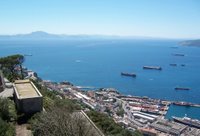
Two things of interest about Gibraltar - the views and the free roaming apes. The views were absolutely incredible. You could see forever in every direction. Morocco (Africa) is 15 miles away - across the strait of Gibraltar - the coastline of Spain is gorgeous and the ocean was dotted with huge tankers that look like large specs from the top of the Rock.
 There are about 200 free roaming apes (tailless monkeys) that live on the Rock. They are everywhere and are quite cute and entertaining. About the time we got off the gondola, one of them snatched an ice cream bar from a teenage girl and managed to fight off all the other apes long enough to eat the whole thing by himself. We walked down from the top via a long, steep, spectacular set of stairs. At one point Deanna was walking ahead of me along a rock wall and two apes, one right after the other, ran along the rock wall right beside and behind her and then jumped off the wall onto her back! She shook the first one off and immediately the second one did the same thing. The first time it happened, I screamed as loud as she did!!! Nothing like literally having a monkey on your back.
There are about 200 free roaming apes (tailless monkeys) that live on the Rock. They are everywhere and are quite cute and entertaining. About the time we got off the gondola, one of them snatched an ice cream bar from a teenage girl and managed to fight off all the other apes long enough to eat the whole thing by himself. We walked down from the top via a long, steep, spectacular set of stairs. At one point Deanna was walking ahead of me along a rock wall and two apes, one right after the other, ran along the rock wall right beside and behind her and then jumped off the wall onto her back! She shook the first one off and immediately the second one did the same thing. The first time it happened, I screamed as loud as she did!!! Nothing like literally having a monkey on your back.
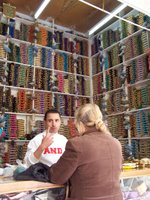
The second day we went to Tangiers, Morocco. We took a ferry from the Spanish town of Tarifa. We “paid for” a tour which we picked up on the Morocco end of the ferry. I say “paid for” in quotes because the total cost of the tour was only about $5.00 more than the cost of the ferry, and the tour included lunch. Apparently they count on you buying souvenirs in Morocco and the tour company gets a commission on what you buy. I’m afraid they probably lost money on us. The tour was a little bit rushed for my taste, but I don’t think we would have seen what we saw had we just gone on our own. The medina (old town) was absolutely fas cinating and a bit bewildering. The “streets” between buildings were really really narrow (some wide enough for a vehicle, some not) and there were lots and lots of little stores, no bigger than medium-sized closets, just big enough for one person to sell and/or make one thing or another - vegetables, bread, blankets, thread, clothing or whatever. Had we been on our own the only thing that might have saved us from getting seriously lost in the maze was that the area was walled and also on the side of a hill so that going down always meant ending up at the harbor. There were peddlers selling souvenirs everywhere and they
cinating and a bit bewildering. The “streets” between buildings were really really narrow (some wide enough for a vehicle, some not) and there were lots and lots of little stores, no bigger than medium-sized closets, just big enough for one person to sell and/or make one thing or another - vegetables, bread, blankets, thread, clothing or whatever. Had we been on our own the only thing that might have saved us from getting seriously lost in the maze was that the area was walled and also on the side of a hill so that going down always meant ending up at the harbor. There were peddlers selling souvenirs everywhere and they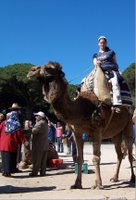 were a GIANT nuisance. Most of the women in Morocco still wear the traditional headscarf. Many also wear the loose-fitting robes - even in the newer parts of the city which we visited later in the day. Some of the men also were wearing the traditional loose-fitting robes but a lot of them - particularly the younger boys - wore western style blue jeans and shirts. I really wanted to wander through the old town on my own after the tour was over and we could have stayed and taken a later ferry back to Spain, but when the time came to make a decision we all decided we had had enough for the day.
were a GIANT nuisance. Most of the women in Morocco still wear the traditional headscarf. Many also wear the loose-fitting robes - even in the newer parts of the city which we visited later in the day. Some of the men also were wearing the traditional loose-fitting robes but a lot of them - particularly the younger boys - wore western style blue jeans and shirts. I really wanted to wander through the old town on my own after the tour was over and we could have stayed and taken a later ferry back to Spain, but when the time came to make a decision we all decided we had had enough for the day.
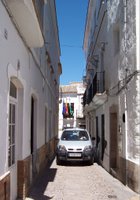 The “White Hill Towns” of Andalucia are just that ---- the buildings are all white and built on the tops of high mountains --- often on the edge of a cliff. Andalucia is the name of the “province” in southern Spain where they are located. Apparently they originally were outposts of the Spanish empire, established as the front line in the fight to recapture Spain from the Muslims. Now they are just really picturesque little towns -- white buildings with speckled tan tile roofs, steep narrow streets, houses built around an inner courtyard that is filled with plants, and
The “White Hill Towns” of Andalucia are just that ---- the buildings are all white and built on the tops of high mountains --- often on the edge of a cliff. Andalucia is the name of the “province” in southern Spain where they are located. Apparently they originally were outposts of the Spanish empire, established as the front line in the fight to recapture Spain from the Muslims. Now they are just really picturesque little towns -- white buildings with speckled tan tile roofs, steep narrow streets, houses built around an inner courtyard that is filled with plants, and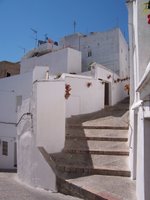 flowers everywhere - in window boxes or in pots attached to the sides of the buildings. The doorways of buildings are typically recessed a foot or so into the front wall and have a doorsill that is about a foot higher than the street. We discovered a couple of very practical reasons for this: (1) if you are a pedestrian and the street is very narrow and a large car comes whizzing by, you can “escape” onto a door sill and (2) the residents can hose off the street when it gets dirty without worrying about the water running down the street into someone’s house.
flowers everywhere - in window boxes or in pots attached to the sides of the buildings. The doorways of buildings are typically recessed a foot or so into the front wall and have a doorsill that is about a foot higher than the street. We discovered a couple of very practical reasons for this: (1) if you are a pedestrian and the street is very narrow and a large car comes whizzing by, you can “escape” onto a door sill and (2) the residents can hose off the street when it gets dirty without worrying about the water running down the street into someone’s house.
 We ate lunch in a little restaurant in Arcos de la Frontera. It had some outside seating across the “street” from the actual restaurant - the “main” street no less (“main” meaning nothing in terms of width - just that it was the only “through” street and was really busy). Every time the waiter stepped out of the door with some food he had to look both ways for cars and motorcycles.
We ate lunch in a little restaurant in Arcos de la Frontera. It had some outside seating across the “street” from the actual restaurant - the “main” street no less (“main” meaning nothing in terms of width - just that it was the only “through” street and was really busy). Every time the waiter stepped out of the door with some food he had to look both ways for cars and motorcycles.
I guess you’ve all figured out by now that I am really intrigued by European architecture and the fact that it is different in every country. Here are a couple of unique things about Spanish architecture: (1) it is very Roman with lots of arched doorways and openings, (2) the doors themselves are huge, made out of wood, and decorated with rows of brass knobs. Often there is a smaller door (the size of a person) cut out of the larger door for everyday use, (3) the bells in church towers hang inside an opening so they can actually be seen, instead of being incased in a room at the top of the tower as they often are in other countries, (4) roofs are made out of tile that is curved instead of flat, making the roof look like a giant piece of colored corrugated cardboard, and (5) chimneys often have their own little tiled roof at the top of them - only about a foot square but a miniature of the main roof. In Portugal the chimneys were pointy on the top, like miniature lighthouses.
(the size of a person) cut out of the larger door for everyday use, (3) the bells in church towers hang inside an opening so they can actually be seen, instead of being incased in a room at the top of the tower as they often are in other countries, (4) roofs are made out of tile that is curved instead of flat, making the roof look like a giant piece of colored corrugated cardboard, and (5) chimneys often have their own little tiled roof at the top of them - only about a foot square but a miniature of the main roof. In Portugal the chimneys were pointy on the top, like miniature lighthouses.
One of the White Hill Towns that we visited (Ronda) is more or less the birthplace of bull-fighting as it is practiced today. Apparently bullfighting was started by some Spanish king as military training for his soldiers. We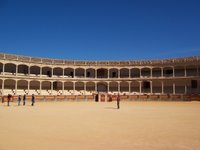 toured the bull ring in Ronda and that was interesting. We didn’t really have any opportunities to actually go to a bull-fight anywhere, but I’m not sure we would have taken the opportunity even if there had been one -- somehow that has no appeal to me. Amy went to a bull-fight when she was in Madrid, so she was able to fill us in on how it all works. One of the books she read for her Hemingway class was “Death in the Afternoon” which is apparently a detailed description of a bull-fight.
toured the bull ring in Ronda and that was interesting. We didn’t really have any opportunities to actually go to a bull-fight anywhere, but I’m not sure we would have taken the opportunity even if there had been one -- somehow that has no appeal to me. Amy went to a bull-fight when she was in Madrid, so she was able to fill us in on how it all works. One of the books she read for her Hemingway class was “Death in the Afternoon” which is apparently a detailed description of a bull-fight.
The climate and vegetation in both Spain and Portugal are a lot like Arizona but a little less dry. Enough moisture to grow crops, but also lots of yucca plants and wide open spaces.
 On the way to Portugal we starting noticing that all the trees beside the road had had their bark removed from about eye-level down. We stopped to check it out and discovered they were cork trees -- a variety of oak tree from which we get cork. The bark (cork) can be harvested every 9 years until the tree is about 150 years old. In other places we noticed acres and acres of a different kind of tree that clearly was planted intentionally - fairly spaced out and in rows, but not a typical fruit tree. We eventually concluded that these were olive trees.
On the way to Portugal we starting noticing that all the trees beside the road had had their bark removed from about eye-level down. We stopped to check it out and discovered they were cork trees -- a variety of oak tree from which we get cork. The bark (cork) can be harvested every 9 years until the tree is about 150 years old. In other places we noticed acres and acres of a different kind of tree that clearly was planted intentionally - fairly spaced out and in rows, but not a typical fruit tree. We eventually concluded that these were olive trees.
Moving on to Portugal (pronounced por-too-GAUL). The coast of Portugal that connects with the southwestern coast of Spain is called the “Algarve” (I never figured out if the final “e” is pronounced - it would be in Spanish, but Portuguese is different). In Spain, it seems to be assumed that everyone speaks Spanish, tourist or no, and every conversation starts out in Spanish. Amy was a great help in translating and was always able to get information for us when we needed it. In Portugal, if you look like a tourist it is assumed that you speak English and you are addressed in English.
We spent 2 nights in a campground in Salema, Portugal. The campground was really nice, with great views, and a nice breeze - also a “zona natural” for nudists. Hmmmm. Obviously we didn’t camp in that area, but we ended using the bathroom there - each time with great intrepidation. Fortunately, it wasn’t quite warm enough either in the morning or evening to  go nude so we were spared that visual experience.
go nude so we were spared that visual experience.
The coast of Portugal is alternately spectacular cliffs and beautiful sandy beaches. At a town called Lagos (LAH-gosh) we took a sailboat / motor boat tour of a coastal area where there was an abundance of  haystacks and ocean grottos. It was a lot like the Twelve Apostles on the Great Ocean Road in Australia (Lisa Hester - this is for you!) except that there was no surf - the water was quite calm. It was a little windy that day and business was slow, so we got a personal tour and extra cheap at that! They took us out to the area of interest in a double masted sailboat - watching them rig the sails, etc was neat - and th
haystacks and ocean grottos. It was a lot like the Twelve Apostles on the Great Ocean Road in Australia (Lisa Hester - this is for you!) except that there was no surf - the water was quite calm. It was a little windy that day and business was slow, so we got a personal tour and extra cheap at that! They took us out to the area of interest in a double masted sailboat - watching them rig the sails, etc was neat - and th en transferred us to a motor boat to duck in and out of the various rock formations along the coast. It was a great day for picture taking and a really neat area to explore. The water was a little too cold for swimming. It would be fun to be there later in the summer and explore the same area from the water in a swimsuit.
en transferred us to a motor boat to duck in and out of the various rock formations along the coast. It was a great day for picture taking and a really neat area to explore. The water was a little too cold for swimming. It would be fun to be there later in the summer and explore the same area from the water in a swimsuit.
Later that day we drove out to the very tip of Portugal - the end of the known world, prior to Columbus - a place called Point Sagres (pronounced SAA-gresh). Again the views were spectacular. At supper time, we found a really neat restaurant in Sagres. To start with, as we sat down, we all noticed a plate of food at the next table that looked REALLY good - some kind of meat and potatoes and gravy and peas all mixed together. We asked the waiter what it was and he told us, but said that it wasn’t on the menu: the cook made it just for the employees. Then he checked with the cook and said there were 2 more plates of it that we could have. Amy and Deanna pounced. Mike and I ordered off the menu. Whatever it was that Mike asked for off the menu elicited an interesting response from our waiter. He said (in English) “It will take longer. . . . first I must make fire!” At that point we knew that we had discover a our own “back door” in Portugal. All the food was delicious and we left totally content for the grand sum of 33 Euros for the 4 of us.
with, as we sat down, we all noticed a plate of food at the next table that looked REALLY good - some kind of meat and potatoes and gravy and peas all mixed together. We asked the waiter what it was and he told us, but said that it wasn’t on the menu: the cook made it just for the employees. Then he checked with the cook and said there were 2 more plates of it that we could have. Amy and Deanna pounced. Mike and I ordered off the menu. Whatever it was that Mike asked for off the menu elicited an interesting response from our waiter. He said (in English) “It will take longer. . . . first I must make fire!” At that point we knew that we had discover a our own “back door” in Portugal. All the food was delicious and we left totally content for the grand sum of 33 Euros for the 4 of us.
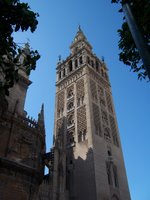 The next day we headed back to Rota, stopping in Sevilla on the way. Sevilla is a fairly large city with a really big cathedral - the largest in Europe. We spent several hours looking for the barber, but he was nowhere to be found . . . . . . ask a musician if you didn’t get that. What we did witness (and actually stopped intentionally to see) was a big festival, called the “feria de abril.” It was sort of like a country fair minus all the livestock and contests. The fairgrounds were within walking distance of the old town area and were filled with wall-to-wall party tents -- some set up by individual families, some by groups and organizations. The feria goes on 24 hours a day for about 10 days, but the real action starts about 6 PM each day. You
The next day we headed back to Rota, stopping in Sevilla on the way. Sevilla is a fairly large city with a really big cathedral - the largest in Europe. We spent several hours looking for the barber, but he was nowhere to be found . . . . . . ask a musician if you didn’t get that. What we did witness (and actually stopped intentionally to see) was a big festival, called the “feria de abril.” It was sort of like a country fair minus all the livestock and contests. The fairgrounds were within walking distance of the old town area and were filled with wall-to-wall party tents -- some set up by individual families, some by groups and organizations. The feria goes on 24 hours a day for about 10 days, but the real action starts about 6 PM each day. You  have to know the right people to get into any of tents where the drinks and (later on) the food is sold, but just walking around the fairground was pretty interesting.
have to know the right people to get into any of tents where the drinks and (later on) the food is sold, but just walking around the fairground was pretty interesting.
The tents were arranged along temporary streets named for famous bull-fighters. These “streets” were filled with an endless parade of horses, decked with colorful bells and pulling carriages. In the carriages were men dressed in traditional Spanish riding clothes and women in flamenco dresses of every imaginable color or combination of colors. Many of the women not riding in carriages were also decked out in colorful flamenco dresses -- even babies in strollers. Lots of young girls rode side-saddle behind their beaux (oophs, wrong word for Spain). Spanish music drifted out
Spain). Spanish music drifted out of the various tents and people danced to it. We really would like to have stayed longer, but we had to be back in Rota by 11:00PM to return our camping gear at Outdoor Rec and catch a plane the next morning in Jerez.
of the various tents and people danced to it. We really would like to have stayed longer, but we had to be back in Rota by 11:00PM to return our camping gear at Outdoor Rec and catch a plane the next morning in Jerez.
So that is our trip to Spain - for those of you die hards who are still with me. If you are still reading at this point you must be either really lonely, really bored, or LOVE to travel.
Our next trip is back to the US for Alan’s graduation. Hopefully I will see some of you in the Tacoma, Washington area when Alan and I get there around May 17th.
Nancy
